“May the Holy Triune God, the Omnipotence of the Father, the Wisdom of the Son, and the Love of the Holy Spirit, be known, loved and praised by all.” (Prayer of Petitions)
Trinity Sunday as a missionary feast
The missionary vision of Fr. Arnold Janssen arose from his spirituality centered on the Trinity. From this source it derives its depth and enduring vitality. Trinity Sunday was considered as a primary feast in the Society. For Fr. Arnold the Blessed Trinity was an excellent missionary feast along with Pentecost Sunday, which is also a principal feast of the Society. The Rule of 1891/4,3 made the feast of the Most Blessed Trinity the principal feast of the Society: “Since God is Trinitarian, the glorification of the most Holy Trinity is the first and last purpose of our Society” and “We spread the devotion to the Holy Spirit in a way that gives honor to all three persons of the Blessed Trinity” (1891/1,4). Thus, the Society celebrated this feast as the highest rank long before it became a principal feast in the Church (1911).
The Constitutions of 1905 mentioned that the Feast of the Blessed Trinity is the Society’s highest feast as the missionaries are sent out in its name. The Constitutions of 1910/405 tell us: “By the wish of our founder, we place special emphasis on the feast of the Most Blessed Trinity since our calling is deeply rooted in the mystery of the sending of the Eternal Word and the Holy Spirit. As missionaries, we proclaim the majesty and love of the Triune God and introduce new members into the kingdom of God through baptism in his name.” Also, every Sunday was to be devoted to the Blessed Trinity, envisioned as a special thanksgiving to the Divine Persons for the graces of Creation, Redemption and Sanctification.
Vivat Deus Unus et Trinus in Cordibus Nostris
The Founder’s all-embracing vision of mission also found its expression in the brief prayer: “Vivat Deus Unus et Trinus in Cordibus Nostris” (May the Holy Triune God live in our hearts and the hearts of all people). This prayer, which emanates a missionary dynamism, was the aim and driving force of Arnold’s life and the inspirational prayer for all of Fr. Arnold’s foundations. It embodies his missionary charism so that all can participate in the life of the Blessed Trinity. This vision of mission, based on his deepest love and adoration of the Blessed Trinity, meant the fulfillment of the will of God and the intentions of the Sacred Heart of Jesus. “All must serve the Triune God; all must be done in the name of the Holy Trinity; all hearts must become its abode (…). The Triune God is drawing the whole of humanity into a perfect communion of life and love with the Father, Son, and Holy Spirit.” Fr. Arnold wanted that his missionaries would follow his wish that the Triune God could live in the hearts of all people.
Initially, there existed the Latin Formula “Vivat Cor Jesu in cordibus hominum” (May the Heart of Jesus live in our hearts) related to the Sacred Heart. For the first time, it appeared on the title page of the June 1874 issue of the Little Messenger of the Sacred Heart and was used by the Founder for the first time on his thanksgiving letter to the Poor Sisters of St. Francis in Aachen on 19 March 1875 (“Nova et Vetera” 1977, 159). In August 1875, Fr. Arnold made this Latin formula also the motto of the Mission House and placed it over the picture of the Sacred Heart in the corridor of the Mission House on its opening day in Steyl on 8 September 1875. Initially, the members of the house even greeted each other with this salutation. This missionary motto was applied increasingly to the Holy Trinity, especially in his indwelling in the hearts of men through grace. Its new emblematic version: Vivat Deus Unus et Trinus in Cordibus Nostris (acronym VDUETICN) appeared as the concluding prayer of the 1885 September Rule. Since then, the Founder quoted this in his daily letters for almost a quarter of a century. Moreover, the Second and Third General Chapters introduced this missionary motto as a rule: “Whenever we write to one another, we will write at the top of the page: ‘May the Holy Triune God live in our hearts.’ If he lives in our hearts it will be easy to keep his name holy and obey his will; for then he is the motivating force of our actions.” (Con 1891/59,1 and 1898/62,1)
The indwelling of the Trinity in the Sacred Heart
For the Founder, the Sacred Heart devotion was intimately connected with the three Persons of the Holy Trinity. Fathers Bornemann and Fischer were of the opinion that “more and more in the course of the Founder’s life the first and all-pervading object of his piety was the Blessed Trinity under the aspect of its indwelling through grace in our hearts.” This piety arose from Arnold’s favored idea of the indwelling of the entire Blessed Trinity in the Sacred Heart of Jesus: “Thus the whole Holy Trinity resides in the Heart of Jesus. Present are omnipotence of the eternal Father, the wisdom and beauty of the Eternal Word, the eternally generous love and wealth of the Holy Spirit. What a holy wonder, because the Heart of Jesus remains ever human.” (Little Messenger of the Sacred Heart, 1874, 203) The Heart of Jesus was the tabernacle of the Trinity; it is an entirely divine and human Heart, the furnace of limitless and never-ending Love, the source of all that is good and beautiful. We are to honor the Blessed Trinity with our love, in word, by prayer, preaching, and in deeds.
Mission Story of the Trinitarian Love
The essence of Christian Faith consists in discovering God as the infinitive Love in the human person, in all its weaknesses and powerlessness. The Founder longed that all people might come to the knowledge of this wonderful mystery and share in the community of Divine Love. He wrote in his Manual of Common Prayers for Lay People (1871): “Souls who have often reflected on the Blessed Trinity are filled with great reverence for the Divine majesty and are raised to a very high degree of love for that ineffable purity and sanctity which we adore in the Divine Nature.”
Our general purpose is to serve God and neighbor by spreading the knowledge and love of the Most Holy Trinity.(The preliminary draft of the Mission House Statutes ,August 1875). Fr. Arnold was always attracted by the beauty and the richness of the intimate life of the Divine Persons, and he desired that all people could share his happiness. The Rule of 1898/5 shows clearly that Fr. Arnold based his missionary vision on the mystery of Trinitarian life. It was designed to bring all people into a communion of love through Christ in the Spirit: “Therefore let us be faithful sons of the Father and the Son and the Holy Spirit, especially to the Father who is the principal root of the Blessed Trinity to whom all are to return. Since we have been created, redeemed and sanctified by the rays of His love, let us remain His most obedient and loving sons. Let us propagate His Kingdom of love on earth and let us work for this so that the Father be more and more loved in the Son and the Holy Spirit. Because of the love they have for the Father as their origin, they promote the honor of the Father on earth. And since they desire all men to return to the bosom of the Father, let us be their co-workers and let us be their instruments, though weak.”
The Seat of Mercy
The Founder visualized the missionary aspect of the Trinitarian spirituality on the tabernacle door of the Upper Church in Steyl with an image of the seat of mercy. The Holy Spirit in the form of a dove hovers above God the Father who is holding on his lap the body of his beloved Son Jesus. It symbolizes the Eternal Father who surrenders his only Son for humanity’s sake to death on the cross, and through the power and presence of the Spirit, he wishes to draw all people into this mystery of love and compassion. (Rehbein, The Mystery of God’s Love, 38) This vision generated in Arnold much energy and was translated into a practical theology of mission. Despite tremendous ordeals, Fr. Arnold preserved the unwavering trust in the Triune God as he followed the principle of St. Therese of Avila: “God alone is sufficient.” All his life, he faithfully walked in the presence of the Triune God and anchored himself in His Love. He remained calm in the midst of many activities in his office, walking in the presence of God in humility and modesty and preserving the inner freedom to take every decision that had to be made.
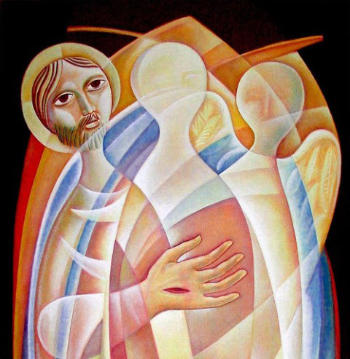
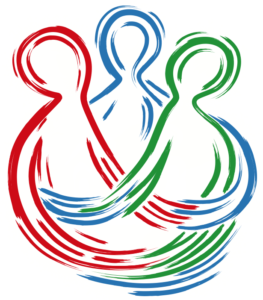
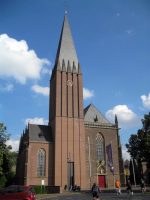

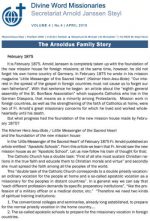
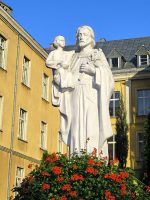
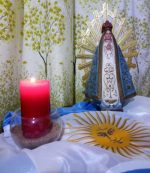
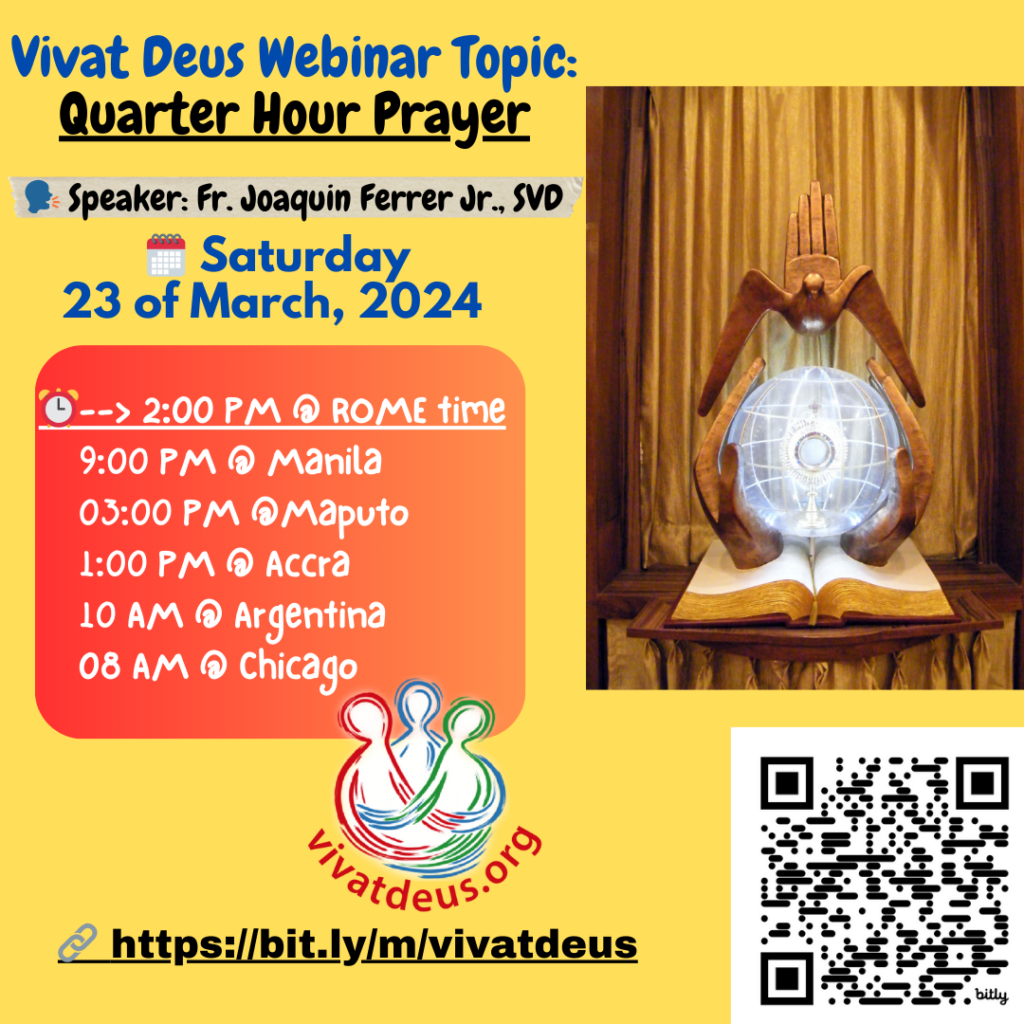
One Response
“La silla de la misericordia” es un motivo, que se repite en el diseño de los altares autorizados por san Arnoldo. Está por ejemplo en la parte superior de la Iglesia en Nysa y en el ápside de la capilla en Buenos Aires. Seria interesante analizar esta temática, pero en muchas casas e iglesias el diseño fue cambiado radicalmente, y en las iglesias de la China – totalmente destruido.